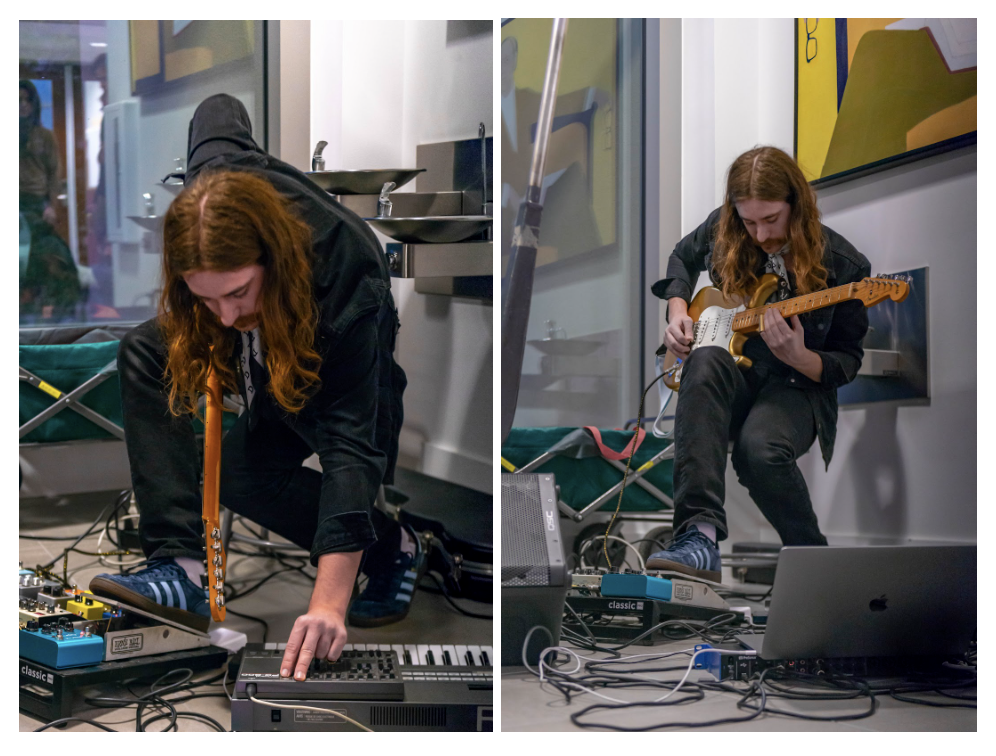What Does Nostalgia Sound Like?
Santa Clara’s Simon Lanzoni reflects on childhood in the opening of his audiovisual installation in Dowd Hall’s new gallery space
Standing across the hall from a corner carefully arranged with a plethora of audio equipment, Simon Lanzoni, in an ascot and black denim jacket, introduced his audiovisual installation Reflections. The piece features a mirror veiled by – but visible through – a gauzy shroud of black fabric as well as a spacey, ambient audio track.
At an opening on Thursday, Jan 26, the artist presented his immersive artwork in an inconspicuous alcove on the third floor of the Edward M. Dowd Art and Art History Hall.
Lanzoni’s project came about during a period in which he had been pondering childhood and its joie de vivre, as he fondly described it.
“There’s an emotional disconnect that you feel from past versions of yourself,” he explained. “It feels like you’re looking back at someone else, like time has been a barrier between these two versions.”
The auditory aspect of the piece exemplifies Lanzoni’s unconventional approach. Majoring in music, the artist has been incorporating sound into visual art since he began taking sculpture classes with Ryan Carrington, sculpture lecturer at Santa Clara.
“He kept talking about this music thing he had going,” said Carrington. “It culminated in this installation, which takes over the space in the way the audio takes over the space.”
The artist leans into the viscerality of auditory experience in order to create an immersive installation.
“There’s something about the physicality of sound that’s really important to my work, particularly with sculpture,” said Lanzoni. “Sculpture is a three-dimensional art form and sound is very much a physical experience. When you pair the two together, you bring the sound into the third dimension. The sculpture becomes a physical experience.”
Following an introduction, onlookers gathered to stand or sit around Lanzoni’s setup as he rounded out the installation with a live performance of the audio track, sitting on the floor across from the sculptural aspect of the piece.
Lanzoni’s gold guitar ran through seven of the eleven pedals on his pedalboard, and then into his laptop along with a synth. The output was an introspective and ethereal resonance that filled the hallway.
The audio draws on the artist’s reminiscence, incorporating influences that span from a specific Ed O’Brien song to the ambient drone genre to the work of Beach House, which elicit strong reactions in Lanzoni and help him to reflect on specific memories from his childhood.
“There’s a particular sound that I associate with the feeling that I’m taking on in this work,” he said. “I was listening to all of these influences and trying to synthesize them into something original.”
In Dowd, over-the-ear headphones wired to a miniature mp3 player accompany the sculpture so visitors can experience the installation in its entirety.
Despite its current presentation, the auditory portion of the installation is not an accompaniment to the visual aspect – the two are meant to work in tandem. Lanzoni’s combination of sound and sculpture is an avant-garde immersion of the viewer/listener into a multidimensional and physical encounter.
While it’s now carefully draped with translucent fabric, the miniature gallery housing the installation previously accommodated a vending machine. The transition of the space is part of the Santa Clara Art and Art History Department’s push to display student work.
“We want to share the work of our students and celebrate their labor, efforts and creativity,” said Carrington. “Beyond that, when a student is looking at a career path in the creative industries, events like this are good experiences in terms of putting yourself out there and taking care of installations.”
The current plan is to host two student installations in the alcove each quarter, with each lasting for four weeks. In the case of more interest, there is the possibility of a more frequent rotation of student works that escape the conventional.
The third-floor gallery is unique in that it offers a space to be filled with complex installations like Lanzoni’s rather than more orthodox stand-alone pieces.
“It lends itself more to the experimental,” said Carrington. “What Simon’s put together here is not a traditional art show, and the art isn’t traditional artwork.”





